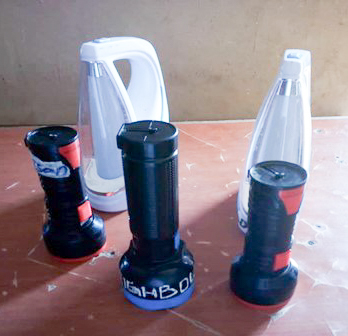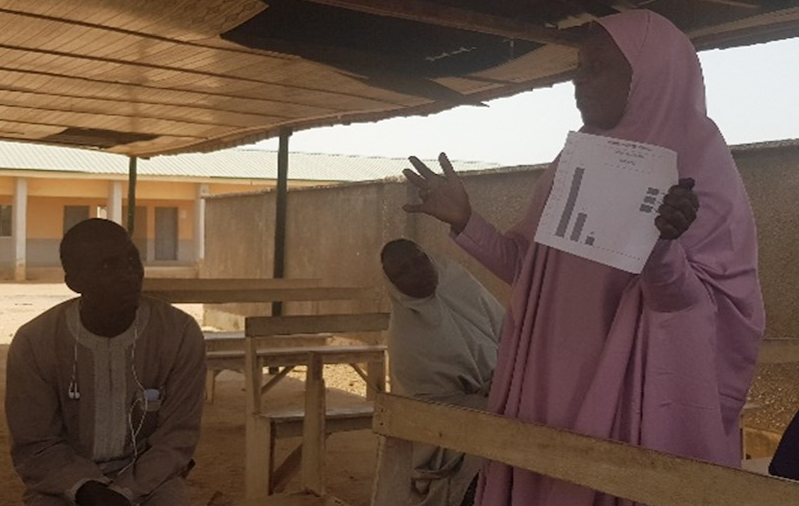Evidence-Based Decision-Making by Ward Development Committee in Miyetti PHC
Background
The Kaduna PHC Management Strengthening Project (KPMSP) is being implemented in 107 Ward Priority PHCs spread across 10 Local Government Areas in Kaduna State. The project aims to improve the management capacity of PHC Managers by developing and deploying a systems framework within which the managers would operate (job description, competency framework, management curriculum); and providing them with in-class and on-the-job capacity building.
In the course of the intervention, PHC Managers (Officers-in-Charge and their deputies) have received training on the thematic areas of the project ─ Data Management, Planning and Community Relations, Inventory and Supply Chain Management, Human Resources Management, and Financial Management.
LGA- and Zonal-level Supervisors, and Ward Development Committee (WDC) members have also been part of the capacity-building sessions on PHC management, aimed at improving the supervisory and oversight functions they provide at their respective PHC facilities.
About Miyetti PHC
The intervention has begun to yield positive results in several of the thematic areas listed above. A case in point is Miyetti PHC in Igabi Local Government Area of Kaduna State (one of the focus PHC facilities), where the Ward Development Committee improved the facility’s output through evidence-based decision-making.
Miyetti PHC is located in the heart of the Rigasa community in Igabi Local Government Area of Kaduna State. It commenced operations in 1990 and has a catchment population of about 48,749. It is one of nine KPMSP intervention PHC facilities in Igabi Local Government Area and its managers have benefited from both in-class and on-the-job management capacity building from February 2021.
The PHC managers who had been trained on Data Management had begun to carefully curate, analyze, visualize, and disseminate their facility data to Ward Development Committee members during their monthly meetings.
In April 2020, the OIC presented the data analysis for the previous month which showed that the number of deliveries taken in the facility during the month was very low when compared to the number of women who attended Antenatal Care (ANC). This had been the situation over a period. Upon further investigation by the OIC, it was discovered that while pregnant women felt comfortable coming to the PHC facility for ANC during the day, many of them were firmly against the idea of coming to the PHC for deliveries for three reasons:
• The PHC did not have 24-hour operations
• The PHC lacked adequate security, as there was only one security guard
• The PHC lacked grid electricity
Results
Using the evidence from data generated in the facility, the OIC advocated to the WDC for the restoration of grid electricity, security guards, and a security post to inspire more confidence in the PHC’s capacity to take deliveries in a secure and comfortable environment.
The WDC members, also having been trained on PHC management by the KPMSP, committed to addressing the three issues identified.
A Rigasa-based Community-Based Organization (CBO), Kwana Bushara Neighborhood Development Association, was approached by the WDC and together, they have been able to achieve the following:
• The engagement of three security guards who are currently providing round-the-clock security for the PHC facility
• The deployment of policemen from the Rigasa Police Division for night patrol of the PHC facility area, after the WDC visited the Divisional Police Officer to discuss security, which has complemented the facility’s security arrangements
• Reconnection to the national grid after the WDC’s intervention
On its own, the CBO has commenced construction of a security post in the PHC facility. It has also donated rechargeable torch lights and lamps to the PHC.

Rechargeable lamps and torch lights donated by the CBO 
Security post under construction

All these have resulted in the commencement of 24-hour services at the PHC. In terms of results, the facility’s data showed that the average number of deliveries in Miyetti PHC increased from a monthly average of 22 (before April 2021), to 50 in May 2021. There was also an increase in the number of in-patients from a monthly average of 3 (before April 2021) to 15 in May 2021.
These improvements can be directly attributed to the KPMSP’s targeted capacity-building interventions. Through these, the PHC OICs have developed the skills to link the data generated in their facilities to results and gain insights on bottlenecks. They can also conduct advocacy for change and ultimately improve the health of the people of the community in which the facility is situated.
By HSDF’S KPMSP team. Special contributors were: Aliyu Tukur, Muhammad Awwal Waziri, and Abolade Oyelere
Grants and Business Development Specialist
We are seeking a highly motivated and experienced Grants and Business Development Specialist to join our organization. The successful candidate will be responsible for identifying funding opportunities, developing grant proposals, and fostering partnerships with potential donors and stakeholders (regional and global). This role plays a vital part in securing funds and resources to support our organization’s mission and projects.
Apply NowPublic Health Consultant, Guinea
The consultant (working with the Accelerator team) will collect results from the tool, organize a meeting with stakeholders to discuss results from the tool, and produce a report on key findings and recommendations from the tool to be shared publicly.
Apply NowPublic Health Associate, Senegal
We are currently in search of an experienced Public Health professional in Senegal to work on the anticipated Nutrition Capacity Development and Financing Platform and provide technical assistance to elevate nutrition financing and strengthen local capacity to support these efforts. The Associate must be bilingual (English and French).
Apply Now